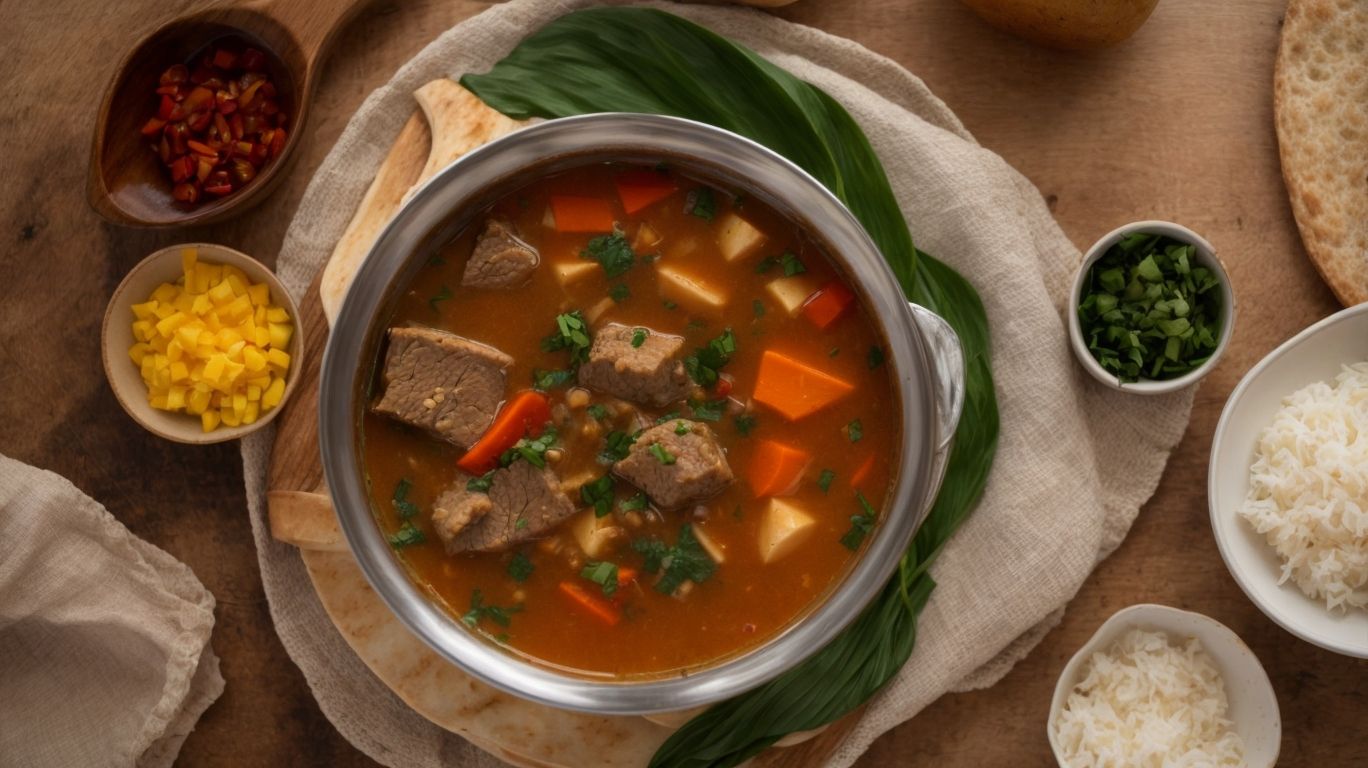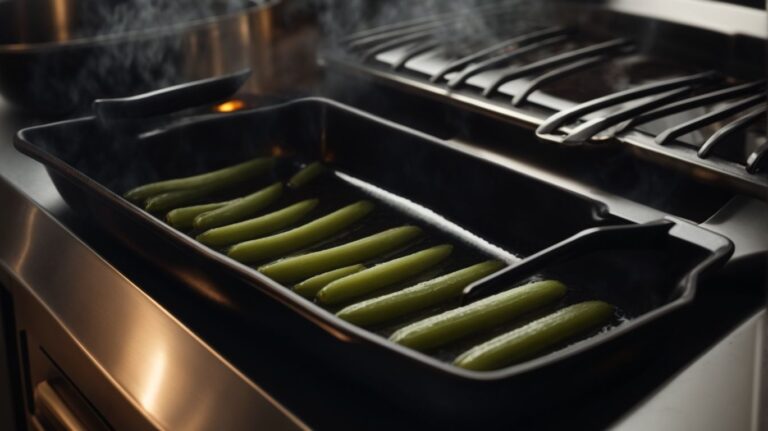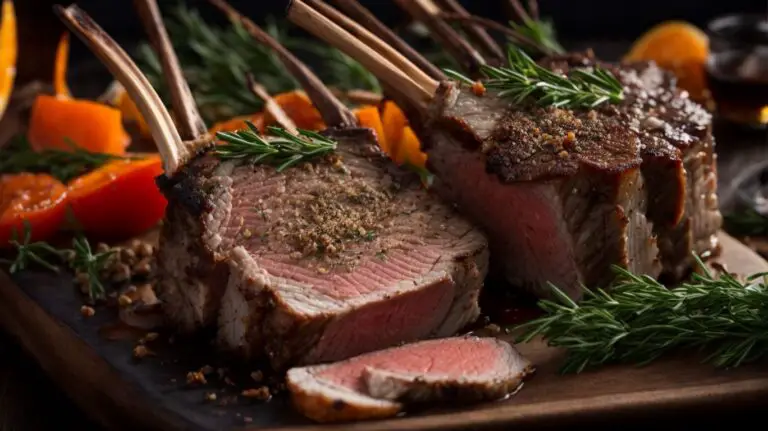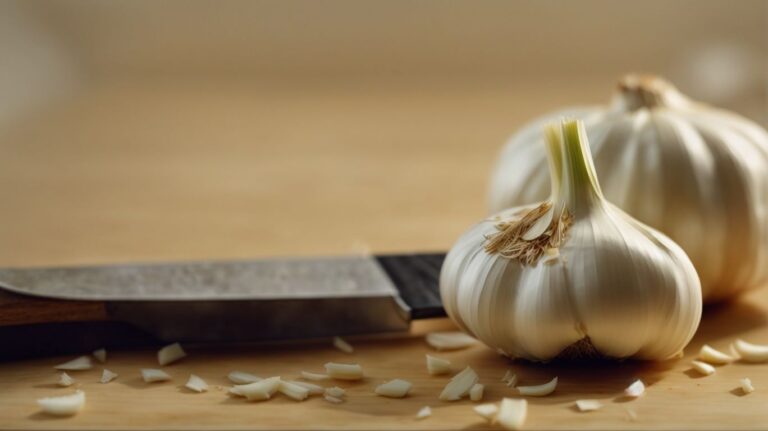How to Cook Ogbono Soup With Ugu?
Are you looking to expand your culinary skills and try something new in the kitchen? Look no further than Ogbono Soup with Ugu!
In this article, we’ll explore the rich flavors and textures of this traditional Nigerian dish. From the essential ingredients to step-by-step instructions on how to prepare the perfect batch, we’ve got you covered.
Plus, we’ll share some expert tips and serving suggestions to elevate your Ogbono Soup experience. Get ready to impress your taste buds and your guests with this delicious and nutritious recipe!
Key Takeaways:
About Ogbono Soup
Ogbono Soup is a traditional Nigerian dish known for its rich and flavorful taste, often accompanied by Ugu leaves for added nutritional value.
Originally, Ogbono Soup hails from the Igbo tribe in Nigeria, where it has been a staple for generations. The soup’s roots can be traced back to the rich agricultural practices of the region, where ogbono seeds are harvested from the wild naturally-growing bush mango tree. The seeds, when ground into a powder, give the soup its unique texture and nutty flavor.
In Nigerian culture, Ogbono Soup holds a special place, often served during celebrations, ceremonies, and family gatherings. It symbolizes unity and togetherness, as it is a dish that is shared and enjoyed communally.
Ugu leaves, also known as fluted pumpkin leaves, are commonly added to Ogbono Soup not only for their earthy taste but also for their myriad of health benefits. These dark green leaves are rich in essential nutrients like vitamin A, vitamin C, iron, and calcium, making the soup not only delicious but also incredibly nutritious. Incorporating Ugu leaves into the soup elevates its overall healthiness and adds a burst of freshness to every spoonful.
What is Ogbono Soup?
Ogbono Soup, also known as Draw Soup, is a popular Nigerian dish made with ground Ogbono seeds and a variety of ingredients such as meat, crayfish, and fresh pepper.
This hearty soup is cherished for its unique thick and viscous texture, which is achieved due to the mucilaginous nature of the Ogbono seeds when cooked. The key to preparing delicious Ogbono Soup lies in the quality of the ingredients used, with palm oil, stockfish, and assorted meat playing vital roles in enhancing the flavor profile.
- To begin cooking this flavorful dish, start by heating palm oil in a pot and adding chopped onions and assorted meat, allowing them to simmer until tender.
- Next, incorporate the ground Ogbono seeds into the mixture, stirring continuously to prevent lumps from forming.
- Gradually adding warm water while stirring helps achieve the desired texture of the soup.
- Once the soup thickens, introduce crayfish, fresh pepper, stockfish, and assorted vegetables, bringing all the flavors together.
What is Ugu?
Ugu, also known as fluted pumpkin leaves, is a versatile vegetable commonly used in Nigerian cuisine, prized for its nutritional content and unique flavor.
Rich in essential nutrients such as vitamin A, C, and E, as well as calcium, the vibrant green Ugu leaves add a healthy touch to soups and stews.
Traditionally, Ugu is chopped finely and added to dishes like Egusi soup, enhancing both the taste and appearance with its dark green hue.
Its slightly bitter taste complements spicy flavors, making it a staple in many Nigerian households.
Not only does Ugu contribute to the deliciousness of dishes, but it is also celebrated for its potential health benefits, such as boosting immunity and promoting good digestion.
Ingredients for Ogbono Soup with Ugu
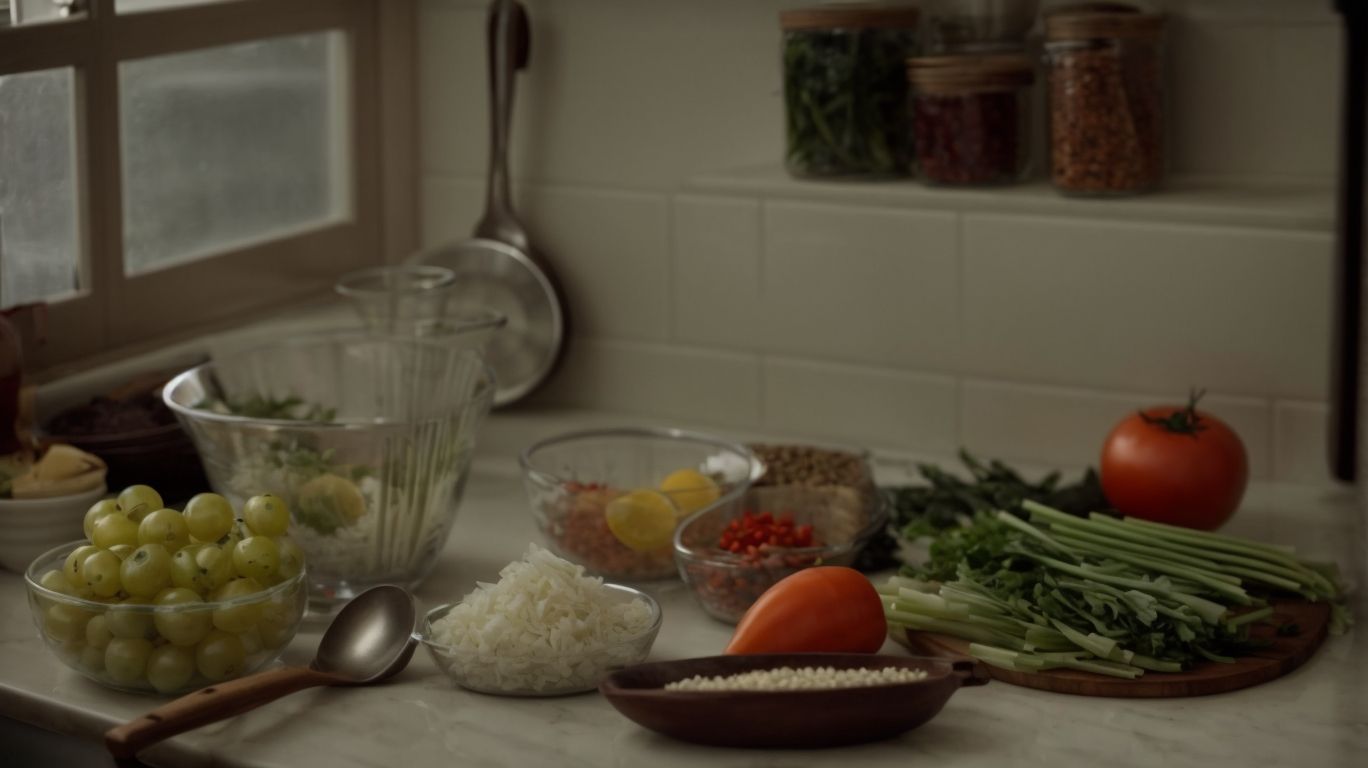
Credits: Poormet.Com – Mark Sanchez
The key ingredients for preparing Ogbono Soup with Ugu include Ogbono seeds, Ugu leaves, salt, palm oil, crayfish, fresh pepper, okpei, onion, Maggi cubes, meat, uziza seed, and water.
When selecting the Ogbono seeds, opt for fresh seeds to ensure the authentic taste and thickening properties of the soup. Ugu leaves, known for their rich nutrients, not only add color but also provide a distinct flavor. The combination of palm oil and crayfish forms the base flavor profile of Ogbono Soup, with the palm oil adding a unique depth and the crayfish lending its umami essence.
Include fresh peppers to bring a kick of heat to the soup, balancing the richness of the other ingredients. Okpei, a traditional African seasoning, imparts a complex aroma, while onions contribute their sweet, savory notes. Maggi cubes are essential for enhancing the overall savoriness.
What Are The Main Ingredients?
The main ingredients for Ogbono Soup are typically meat, uziza seed, Ogbono seeds, and Ugu leaves, creating a hearty and satisfying dish with a distinct flavor profile.
Meat plays a crucial role in Ogbono Soup, providing a rich umami flavor and hearty texture to the dish. Uziza seeds, on the other hand, introduce a unique peppery and aromatic taste, elevating the overall flavor profile. When combined with the nutty Ogbono seeds and the slight bitterness of Ugu leaves, the result is a harmonious blend of flavors and textures.
To bring out the best in these ingredients, it’s essential to properly season the meat before adding it to the soup. Browning the meat beforehand can enhance its flavor and help develop a deeper richness in the broth. Toasting the Ogbono seeds before grinding them can intensify their nutty flavor and thicken the soup to a perfect consistency.
What Are The Optional Ingredients?
Optional ingredients for Ogbono Soup include additional vegetables, crayfish, pepper, and salt, allowing for customization and flavor enhancement based on personal preferences.
Additional vegetables such as okra, spinach, or pumpkin leaves can increase the nutritional value of the soup while adding texture and color. Crayfish introduces a deep, savory umami flavor, complementing the richness of the Ogbono seeds. Along with pepper, it provides a subtle heat that can be adjusted to suit individual spice tolerance levels. Salt, a staple seasoning, brings out the flavors of the other ingredients.
For those looking to experiment further, ingredients like smoked fish or stockfish can lend a smoky depth to the soup, while a dash of palm oil adds a luxurious mouthfeel and richness. Consider incorporating aromatic spices like thyme or scent leaves for a fragrant twist on this classic Nigerian dish.
How to Prepare Ogbono Soup with Ugu
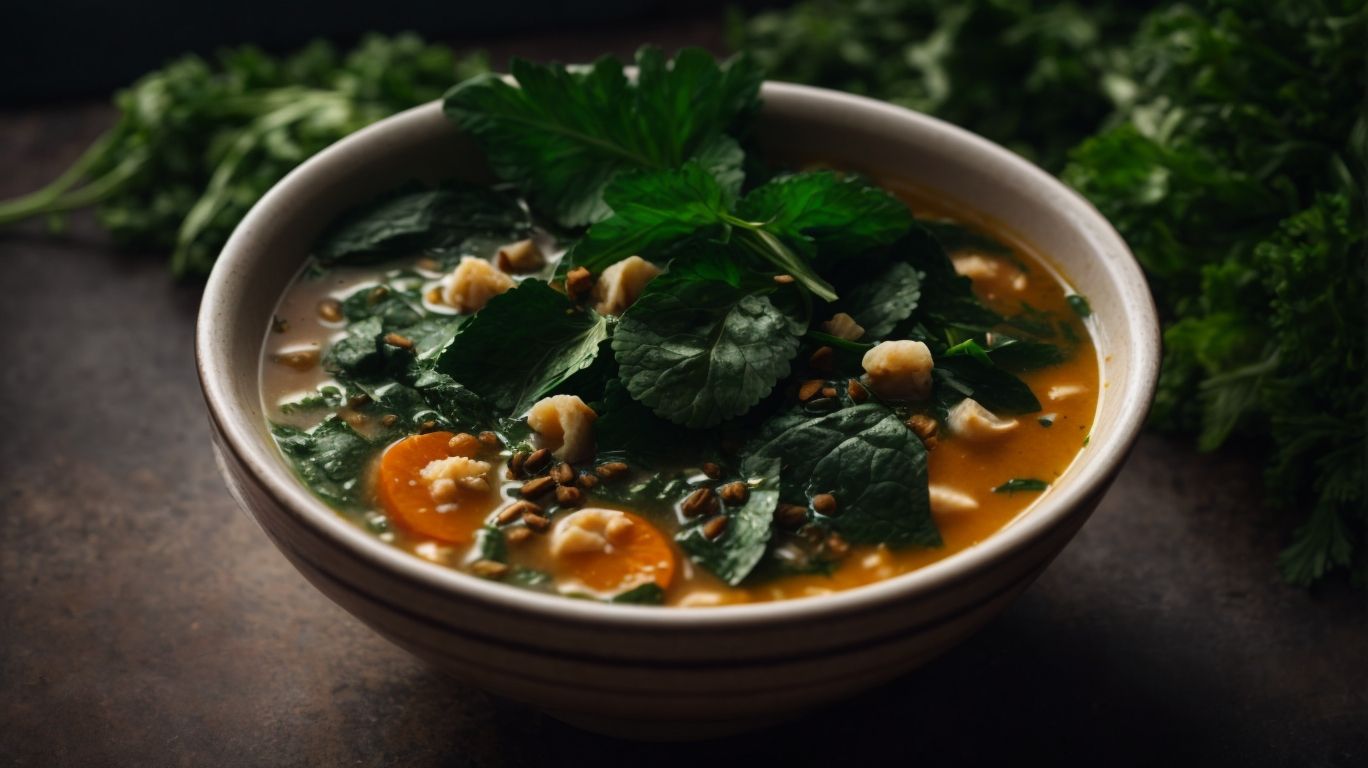
Credits: Poormet.Com – Joe Hernandez
Preparing Ogbono Soup with Ugu involves a series of steps including blending the Ogbono seeds, cooking the ingredients, and simmering the soup to perfection.
Start by blending the Ogbono seeds into a smooth paste to enhance the soup’s thick consistency and characteristic flavor. Next, gather your ingredients, such as stockfish, crayfish, assorted meats, and Ugu leaves, to add layers of taste and nutrients to the dish.
In a pot, heat palm oil and add chopped onions, peppers, and seasoning cubes for a fragrant base. Then, pour in the Ogbono paste, stirring continuously to prevent lumps from forming.
- Simmer the soup over low heat, allowing the flavors to meld and the texture to thicken. Remember to adjust seasoning to suit your preferences.
- Fold in the chopped Ugu leaves, letting them wilt gently in the hot soup, before serving the Ogbono Soup with Ugu piping hot with a side of fufu or rice.
Step 1: Preparing the Ogbono Seeds
To start, blend the Ogbono seeds to a smooth paste, then heat a pot, add water, and cook the blended mixture until it thickens, releasing its characteristic aroma.
Blending the Ogbono seeds is a crucial step in the process of making this authentic West African dish. The key is to ensure the seeds are ground finely to achieve that smooth consistency which helps thicken the soup later on. Once you have the paste ready, it’s time to heat your pot over medium heat. Adding just the right amount of water is essential; too little may lead to a thick and lumpy soup, while too much can result in a watery consistency. Cooking the mixture until it thickens not only intensifies the flavors but also brings out the distinct aroma of the Ogbono.
Step 2: Preparing the Ugu Leaves
Next, wash the Ugu leaves thoroughly, remove the stems, and finely chop the leaves to add a vibrant green color and nutrient-rich element to the soup.
Before washing the Ugu leaves, fill a large bowl with water and gently immerse the leaves, swishing them around to remove any dirt or debris clinging to the surface. Once cleaned, carefully examine each leaf, discarding any damaged or discolored parts.
After washing, pat the leaves dry with a paper towel or clean kitchen cloth to ensure the leaves are not too damp before chopping. To remove the stems, simply hold the base of the stem and run your hand along the spine of the leaf to separate it cleanly.
The vibrant green color of Ugu leaves not only enhances the visual appeal of the Ogbono soup but also signifies the presence of essential nutrients like vitamins A, C, and K, as well as minerals such as calcium and iron.
Step 3: Cooking the Soup
In the final step, mix the cooked Ogbono paste with the Ugu leaves, pour in the broth, fry the additional ingredients, stir well, allow the soup to boil, then cover and simmer until fully cooked.
Once you have mixed the Ogbono paste with the Ugu leaves and poured in the flavorful broth, it’s time to move on to the next crucial step of frying the additional ingredients in the pot of delicious soup. This stage is essential for enhancing the depth of flavors and creating a rich taste profile.
As the ingredients sizzle and release their aromas into the soup, make sure to stir continuously to prevent burning and ensure even distribution of flavors. The frying process helps infuse the soup with a tantalizing aroma and intensifies the overall taste.
After the frying is complete, allow the soup to come to a gentle boil, signaling that the ingredients are well-incorporated. Then, cover the pot and let the soup simmer slowly over low heat, allowing all the flavors to meld together and develop into a harmonious blend.
Tips and Tricks for Making the Perfect Ogbono Soup with Ugu
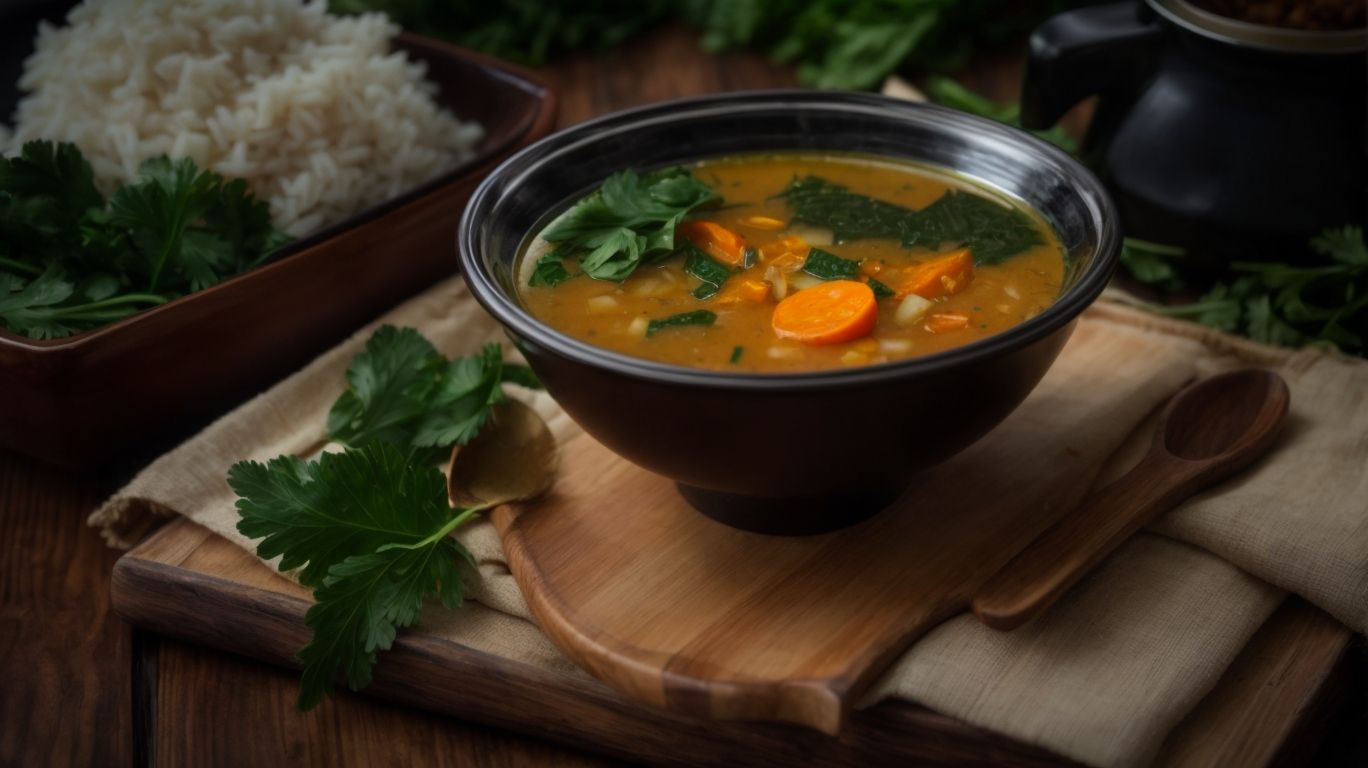
Credits: Poormet.Com – Joe Brown
Mastering Ogbono Soup with Ugu requires attention to detail and a few key tips, such as preventing clumping, adjusting thickness, and storing leftovers properly for future enjoyment.
One essential tip to prevent clumping in your Ogbono Soup is to mix the ground Ogbono seeds with oil before adding them to the pot. This helps to evenly distribute the Ogbono and prevents it from forming lumps.
To adjust the thickness of the soup, you can control the amount of water or stock added during the cooking process. For a thicker consistency, add less liquid, and for a thinner soup, increase the amount of liquid used.
When storing leftover Ogbono Soup, it’s best to transfer it to an airtight container and refrigerate it promptly. This helps maintain freshness and prevents spoilage, ensuring you can enjoy the flavors for longer.
How to Prevent Ogbono Soup from Clumping?
To prevent Ogbono Soup from clumping, ensure consistent stirring during the cooking process to distribute the blended mixture evenly and achieve a smooth, lump-free texture.
Temperature control is another vital aspect in preventing clumps in your Ogbono Soup. Make sure to cook the soup over medium heat, avoiding rapid temperature changes that can lead to uneven cooking and clumping of the ingredients. Additionally, correct ingredient ratios play a crucial role; be mindful of the proportions of Okra, crayfish, and other components to maintain the desired consistency. By keeping these factors in check and following these strategies, you can enjoy a perfectly textured Ogbono Soup every time.
How to Make Ogbono Soup Thicker?
To make Ogbono Soup thicker, consider adding additional ground Ogbono seeds or incorporating natural thickeners like okpei to enhance the soup’s consistency and mouthfeel.
Another effective technique to adjust the thickness of Ogbono Soup is to increase the cooking time after adding the thickening agents. This will allow the flavors to meld together and the soup to reach the desired consistency.
Experiment with different ratios of water and ingredients to find the perfect balance for a thicker Ogbono Soup. Increasing the amount of vegetables, protein, or even palm oil can impact the overall thickness and richness of the soup.
You can also try blending a portion of the cooked soup and then adding it back to the pot to create a thicker base, enhancing the texture and depth of flavor.
How to Store Ogbono Soup?
To store Ogbono Soup properly, allow it to cool at room temperature, transfer it to an airtight container, and refrigerate for up to three days, ensuring freshness and preserving flavors.
When cooling the Ogbono Soup, it’s crucial to bring it to room temperature before refrigerating to avoid condensation that could compromise its taste and texture. Choosing the right airtight container, such as a glass or BPA-free plastic one, helps maintain the soup’s quality by preventing odors from seeping in or flavors from escaping. Remember, always label the container with the date it was prepared to track its freshness. Store the soup in the main section of the refrigerator rather than the door to ensure consistent temperature, preventing spoilage.
Serving Suggestions for Ogbono Soup with Ugu
Pairing Ogbono Soup with Ugu with complementary side dishes can elevate the dining experience, whether opting for traditional accompaniments or modern fusion pairings.
For a traditional touch, serving Ogbono Soup with Ugu alongside a mound of fluffy, white pounded yam or fufu can create a classic Nigerian feast that tantalizes the taste buds. Alternatively, for a contemporary twist, try pairing this rich and hearty soup with a side of quinoa or couscous, adding a global fusion element to the meal.
For those looking to enhance the flavor profile, consider offering slices of ripe plantains or avocado as a refreshing and creamy contrast to the earthy richness of the soup. The sweetness of the plantains or the buttery texture of the avocado can provide a delightful balance to each spoonful of the Ogbono Soup with Ugu, creating a harmonious blend of flavors.
What are Some Traditional Side Dishes for Ogbono Soup?
Traditional side dishes for Ogbono Soup include steamed rice, pounded yam, or fufu, along with a side of sliced onions and assorted meats to complement the rich flavors of the soup.
While steamed rice offers a neutral base that allows the savory essence of the soup to shine through, pounded yam and fufu bring a satisfyingly hearty texture that balances the smoothness of the soup.
For those looking to enhance the dining experience, popular meat options to pair with Ogbono Soup are pieces of tender goat meat, flavorful chunks of fish, or succulent chicken pieces, each adding a unique taste dimension to the meal.
Adding a touch of fresh vegetables, like spinach or bitter leaf, not only enriches the nutritional value of the dish but also adds a pop of vibrant color and a refreshing crunch.”
What are Some Modern Pairings for Ogbono Soup?
For modern pairings, consider serving Ogbono Soup with a side of vegetable stir-fry, plantain chips, or spicy pepper sauce to introduce new flavors and textures to the meal.
Adding a contemporary twist, bring in a quinoa salad with fresh herbs and a zesty vinaigrette for a light yet satisfying complement to the rich Ogbono Soup. For a fusion-inspired pairing, serve the soup with a coconut rice pilaf topped with toasted coconut flakes for a tropical flair.
To elevate the experience further, consider offering a selection of crispy fried plantains alongside the soup, creating a delightful contrast in textures. You could also include a mango salsa with a hint of spice as a refreshing condiment that brightens up the flavors of the soup.
Final Thoughts on Cooking Ogbono Soup with Ugu
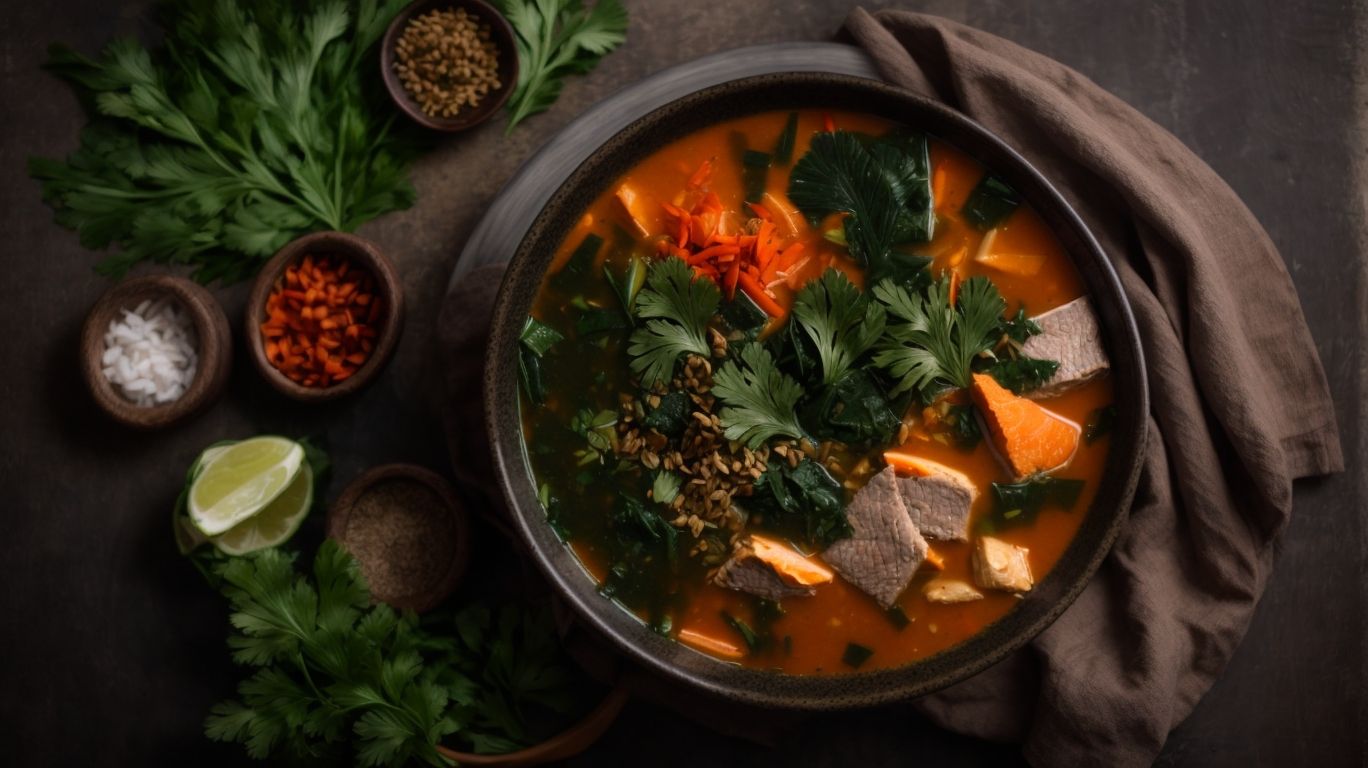
Credits: Poormet.Com – Brian Mitchell
Preparing Ogbono Soup with Ugu is a rewarding culinary experience that celebrates the rich flavors of Nigerian cuisine and showcases the artistry of combining diverse ingredients into a harmonious dish.
Ugu, also known as fluted pumpkin leaves, adds a unique earthy flavor and a touch of bitterness to the soup, balancing the richness of the Ogbono seeds. The process of making Ogbono Soup with Ugu involves softly frying ground Ogbono seeds in palm oil, then adding stock, vegetables, and seasonings such as crayfish and chili peppers. The result is a thick, viscous soup with a luxurious texture and a deep umami taste.
This traditional Nigerian dish holds cultural significance as it is often served during celebrations and gatherings, symbolizing unity and hospitality within communities. The vibrant colors and robust flavors of Ogbono Soup with Ugu embody the essence of Nigerian culinary traditions, making it a beloved and cherished dish among locals and visitors alike.
Frequently Asked Questions
What is Ogbono Soup and how is it different from other Nigerian soups?
Ogbono Soup is a traditional Nigerian soup made with ground Ogbono seeds, palm oil, and various meats and vegetables. It is known for its thick and viscous consistency and is often compared to other soups such as Egusi and Okra Soup.
Can I use frozen Ugu leaves to make Ogbono Soup?
Yes, you can use frozen Ugu leaves to make Ogbono Soup. Just make sure to thaw them completely before using and squeeze out any excess water. This will prevent the soup from becoming watery.
What type of meat is best to use in Ogbono Soup?
Traditionally, beef and dried fish are used in Ogbono Soup. However, you can also use other meats such as chicken, goat, or even seafood like shrimp or crayfish. The choice of meat is up to personal preference.
Can I make Ogbono Soup without palm oil?
Technically, yes, you can make Ogbono Soup without palm oil. However, palm oil is a key ingredient in giving the soup its distinct flavor and thick consistency. If you choose to omit it, the soup may have a different taste and may not thicken as much.
Do I have to grind my own Ogbono seeds for this recipe?
No, you do not have to grind your own Ogbono seeds. Many grocery stores now carry pre-ground Ogbono powder, making it easier for home cooks to make the soup. However, if you have whole Ogbono seeds, you can grind them in a blender or coffee grinder.
Can I freeze leftover Ogbono Soup?
Yes, you can freeze leftover Ogbono Soup for up to 3 months. Make sure to store it in an airtight container and thaw it in the refrigerator before reheating. You may need to add a little water or stock to the soup as it may thicken while frozen.

